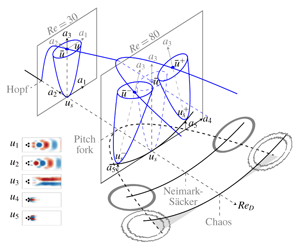Crossref Citations
This article has been cited by the following publications. This list is generated based on data provided by
Crossref.
Bieker, Katharina
Peitz, Sebastian
Brunton, Steven L.
Kutz, J. Nathan
and
Dellnitz, Michael
2020.
Deep model predictive flow control with limited sensor data and online learning.
Theoretical and Computational Fluid Dynamics,
Vol. 34,
Issue. 4,
p.
577.
Chen, Weilin
Ji, Chunning
Xu, Dong
and
Zhang, Zhimeng
2020.
Oscillation regimes and mechanisms in the vortex-induced vibrations of three circular cylinders with equilateral-triangular arrangements.
Physics of Fluids,
Vol. 32,
Issue. 4,
Raibaudo, C.
Zhong, P.
Noack, B. R.
and
Martinuzzi, R. J.
2020.
Machine learning strategies applied to the control of a fluidic pinball.
Physics of Fluids,
Vol. 32,
Issue. 1,
Shahsavari, Mohammad
Wang, Bing
Zhang, Bo
Jiang, Guanyu
and
Zhao, Dan
2021.
Response of supercritical round jets to various excitation modes.
Journal of Fluid Mechanics,
Vol. 915,
Issue. ,
Fukami, Kai
Murata, Takaaki
Zhang, Kai
and
Fukagata, Koji
2021.
Sparse identification of nonlinear dynamics with low-dimensionalized flow representations.
Journal of Fluid Mechanics,
Vol. 926,
Issue. ,
Deng, Nan
Noack, Bernd R.
Morzyński, Marek
and
Pastur, Luc R.
2021.
Galerkin force model for transient and post-transient dynamics of the fluidic pinball.
Journal of Fluid Mechanics,
Vol. 918,
Issue. ,
Callaham, J. L.
Loiseau, J.-C.
Rigas, G.
and
Brunton, S. L.
2021.
Nonlinear stochastic modelling with Langevin regression.
Proceedings of the Royal Society A: Mathematical, Physical and Engineering Sciences,
Vol. 477,
Issue. 2250,
Kaptanoglu, Alan A.
Callaham, Jared L.
Aravkin, Aleksandr
Hansen, Christopher J.
and
Brunton, Steven L.
2021.
Promoting global stability in data-driven models of quadratic nonlinear dynamics.
Physical Review Fluids,
Vol. 6,
Issue. 9,
Guan, Yifei
Brunton, Steven L.
and
Novosselov, Igor
2021.
Sparse nonlinear models of chaotic electroconvection.
Royal Society Open Science,
Vol. 8,
Issue. 8,
p.
202367.
Cortina-Fernández, J.
Sanmiguel Vila, C.
Ianiro, A.
and
Discetti, S.
2021.
From sparse data to high-resolution fields: ensemble particle modes as a basis for high-resolution flow characterization.
Experimental Thermal and Fluid Science,
Vol. 120,
Issue. ,
p.
110178.
Blanchard, Antoine B.
Cornejo Maceda, Guy Y.
Fan, Dewei
Li, Yiqing
Zhou, Yu
Noack, Bernd R.
and
Sapsis, Themistoklis P.
2021.
Bayesian optimization for active flow control.
Acta Mechanica Sinica,
Vol. 37,
Issue. 12,
p.
1786.
Brunton, Steven L.
2021.
Applying machine learning to study fluid mechanics.
Acta Mechanica Sinica,
Vol. 37,
Issue. 12,
p.
1718.
Deng, Nan
Pastur, Luc R.
Tuckerman, Laurette S.
and
Noack, Bernd R.
2021.
Coinciding local bifurcations in the Navier-Stokes equations.
EPL (Europhysics Letters),
Vol. 135,
Issue. 2,
p.
24002.
Ren, Feng
Rabault, Jean
and
Tang, Hui
2021.
Applying deep reinforcement learning to active flow control in weakly turbulent conditions.
Physics of Fluids,
Vol. 33,
Issue. 3,
Kou, Jiaqing
and
Zhang, Weiwei
2021.
Data-driven modeling for unsteady aerodynamics and aeroelasticity.
Progress in Aerospace Sciences,
Vol. 125,
Issue. ,
p.
100725.
Cornejo Maceda, Guy Y.
Li, Yiqing
Lusseyran, François
Morzyński, Marek
and
Noack, Bernd R.
2021.
Stabilization of the fluidic pinball with gradient-enriched machine learning control.
Journal of Fluid Mechanics,
Vol. 917,
Issue. ,
Kaheman, Kadierdan
Brunton, Steven L
and
Nathan Kutz, J
2022.
Automatic differentiation to simultaneously identify nonlinear dynamics and extract noise probability distributions from data.
Machine Learning: Science and Technology,
Vol. 3,
Issue. 1,
p.
015031.
Callaham, Jared L.
Brunton, Steven L.
and
Loiseau, Jean-Christophe
2022.
On the role of nonlinear correlations in reduced-order modelling.
Journal of Fluid Mechanics,
Vol. 938,
Issue. ,
Vinuesa, Ricardo
and
Brunton, Steven L.
2022.
Enhancing computational fluid dynamics with machine learning.
Nature Computational Science,
Vol. 2,
Issue. 6,
p.
358.
Chen, Junwei
Raiola, Marco
and
Discetti, Stefano
2022.
Pressure from data-driven estimation of velocity fields using snapshot PIV and fast probes.
Experimental Thermal and Fluid Science,
Vol. 136,
Issue. ,
p.
110647.



